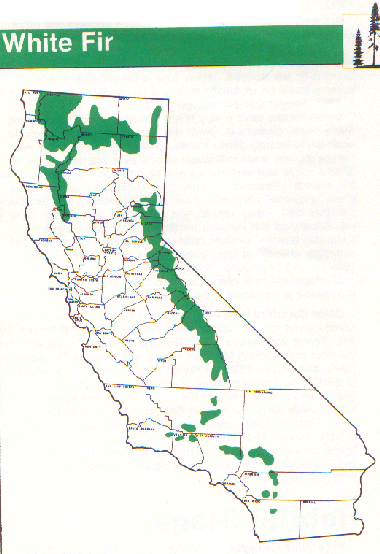White Fir
(WFR) White Fir, Douglas Fir, Sugar PineWhite Fir Forests: A Quick Overview
White fir trees grow in mountain forests throughout California, from the cool north to the warmer southern interior. These forests usually look like tall, dense stands of mostly one kind of tree -- white fir -- with their overlapping branches making deep shade. Northern trees can reach 230 feet tall, while in Southern California, they top out around 100 feet.In open areas or near streams, you might find grasses and flowers on the forest floor, but in thick woods, it is often just a blanket of fallen needles, logs, and branches. Fires create patches of new growth in different stages, making the forest a mix of young and old trees.
Where They Grow
White fir thrives on cool north- and east-facing slopes between 4,500 and 7,000 feet high -- sometimes even higher in isolated desert mountains like the Kingston or New York Mountains. They like cold, rocky soil and need snow and rain between October and May.What Grows With It
While white fir dominates, other plants tag along depending on the area. In the north, you will see oaks, chinquapin, and low shrubs like squawcarpet. In the Sierra Nevada, fir mixes with sugar pine, incense-cedar, and red fir. On the forest floor, plants like snowplant, wintergreen, and manzanita grow depending on the light and moisture.Growth and Changes
- After a fire or logging, white fir forests come back in stages:- Grass/forb stage: First, grasses and wildflowers sprout.
- Shrub/sapling stage: Brush like manzanita and young fir trees move in.
- Pole/medium tree stage: The firs start to outgrow the brush and form a taller layer.
- Large tree stage: Mature firs tower above with shady understories filled with ferns and forest herbs.
These forests can be very long-lived. Mature trees can live 250 to 300 years.
Wildlife
White fir forests are important for wildlife. Old trees often have heart rot, which makes great homes for birds and animals that nest in cavities. Birds like yellow-rumped warblers and mountain chickadees love hunting insects in these forests. Transverse western tanagers,California Wildlife Habitat Relationships System,
California Department of Fish and Game,
California Interagency Wildlife Task Group,
White Fir - Karen Shimamoto

Grand Canyon Plants
Above 8200 feet, spruce-fir forests characterized by Englemann spruce, blue spruce, Douglas fir, white fir, aspen, and mountain ash, along with several ...
Providence Mountains - Lanfair Valley:
Mojave Desert Ecological... Singleleaf pinyon series on higher mountain slopes, and White fir series on the highest mountains. Joshua tree series is common on alluvial plains. ...
Kingston Range - Valley Wells:
Mojave Desert Ecological Subsections: Forests and woodlands: Mesquite series, Singleleaf pinyon series, Singleleaf pinyon - Utah juniper series, Utah juniper series, White fir series. Climate. ...
Wildlife of Yosemite National Park
Along much of Yosemite's western boundary, habitats are dominated by mixed coniferous forests of ponderosa pine, sugar pine, incense cedar, white fir, ...
Vegetation of Yosemite National Park
... forests are found along the western boundary of the park and include trees such as California black oak, ponderosa pine, incense-cedar, and white fir. ...
Grand Canyon natural environments
This is a spruce-fir forest, characterized by Englemann spruce, blue spruce, Douglas fir, white fir, aspen, and mountain ash. ...
Mojave Desert Ecological Subsections
... Creosote bush - white bursage series, Allscale series, Mixed saltbush series, ... pinyon - Utah juniper series and White fir series (high peaks). ...
Palomar - Cuyamaca Peak:
Southern California Mountains and Valleys ...Forests and woodlands: Bigcone Douglas-fir series, Bigcone Douglas-fir - canyon live oak ... Ponderosa pine series, Parry pine series, White fir series. ...
Glass Mountain: Mono Ecological Subsections
White fir series is common at higher elevations, Lodgepole pine series occurs in cold-air drainage-ways, and Singleleaf pinyon series is common in dry areas ...
Southern California Mountains and Valleys
Ecological Subsections... Chamise series, Canyon live oak series, Coast live oak series, Ponderosa pine series, Jeffrey pine series, White fir series and Lodgepole pine series. ...
Kingston Range Wilderness
A small stand of white fir grows at the upper elevations of Kingston peak, and over 500 plant species make this wilderness one of the most botanically ...
Upper San Gorgonio Mountains:
Southern California Mountains and ...Forests and woodlands: Aspen series, Bigcone Douglas-fir series, ... Mountain juniper series, Singleleaf pinyon series, White fir series. Climate. ...
Forest Wildlife List
White Brested Nuthatch Barn Owl Anna's Hummingbird Mountain Chickadee Pygmy Nuthatch ... White Fir Lodgepole Pine Wildflowers Lemon Lily Snow Plant ...
Sierra Nevada Ecological Subsections
Predominant potential natural communities include the Mixed conifer series, Ponderosa pine series, Jeffrey pine series, White fir series, Red fir series, ...
Forest Recreation, Big Bear, CA
Hike the Pine Knot Trail through the lush forest of White Fir and ... Sugarloaf Trail Sugarloaf Trail offers the solitude and peace of the forest . ...
Gray's Peak Trail: Big Bear Adventures
Visit the fascinating world of the forest as you hike among towering Jeffrey Pine and White Fir trees on one of the best trails in the valley. ...
Mono Ecological Subsections
... Singleleaf pinyon series, Shadscale series, Low sagebrush series, Jeffrey pine series, White fir series, Aspen series and Bristlecone pine series. ...
Common plants and animals in the Holcomb Valley, San Bernardino
...White Fir Wildflowers Penstemon Indian Paintbrush.
Big Bear Adventures
White Fir Incense Cedar Coulter Pine Jeffrey Pine Live Oak Sugar Pine. -. top >> mojave << features - wildlife - places - region map - map/sat - roads ...
Pine Knot hiking trail
Hike the Pine Knot Trail through the lush forest of White Fir and Jeffrey Pines from Big Bear to the ridgeline for scenic vistas of San Gorgonio and the ...
Winter Wonderland: Big Bear Adventures
The 2-mile round trip gains 700 feet in elevation through forests of Ponderosa Pine, White Fir, Incense Cedar, and jumbo granite boulders. ...